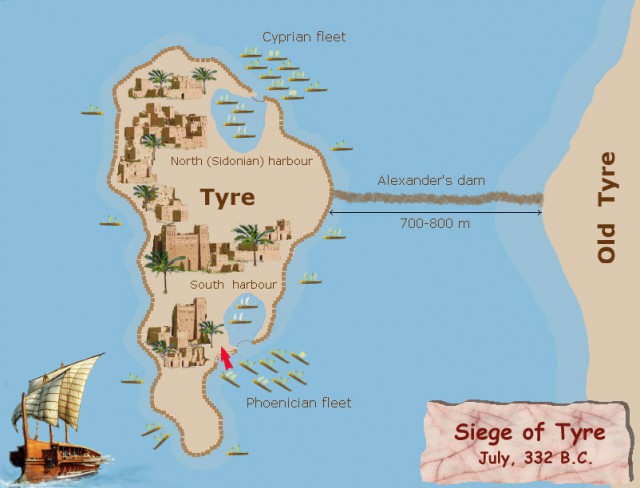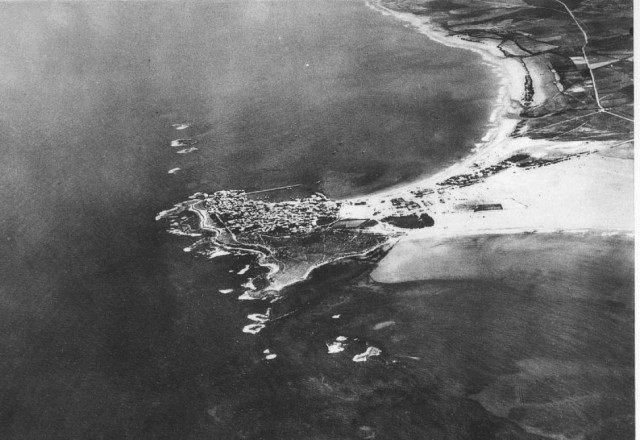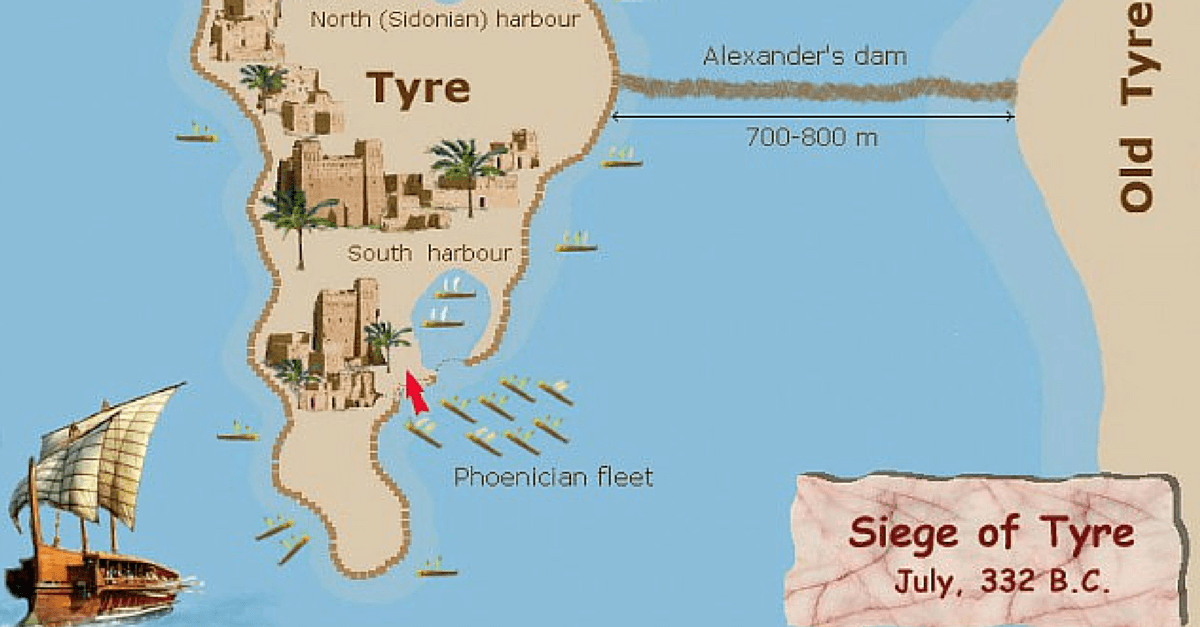By William McLaughlin

As far as great sieges go, the Siege of Tyre is one of the more unique ones. It featured a previously unassailable city fighting against the pride and determination of Alexander the Great and his professional army. If you need an introduction to ancient sieges feel free to see the overview page and other great sieges here.
What makes it great: An island fortress is taken when Alexander the Great decides to extend to earth to meet the city.
Alexander had a great deal of success invading Persia at the young age of 20, thanks to his sound grasp of strategy and highly professional army. Just prior to the siege of Tyre Alexander had routed the Persians at the battle of Issus. Though the Persians lost the battle, they were still in the war. Alexander decided to make his way down the coast to secure his naval supply lines. Many cities capitulated to Alexander without a problem and Tyre planned on allying with Alexander as well.
Tyre was an ancient city originally settled on the coast of modern Lebanon around 2750 B.C.E. It eventually migrated onto an island about a half a mile from the coast. The long island was 1,000 yards at its widest and about 2,500 yards long. The island had two natural harbors, one on the north end and one in the south. Being wealthy from trading in purple dye, the Phoenicians of Tyre traded as far as Africa and possibly India and were able to afford extravagant walls surrounding the island. Ancient authors mentioned walls around 150 feet high. Though this is likely an exaggeration, Tyre still had tall, solid walls surrounding everywhere but the harbors.
The Tyrians worshiped Melqart, an equivalent to the Greek Heracles. In their small island the citizens became very close and worship at their temple was reserved for citizens only. While the Tyrians welcomed Alexander, they refused his request to worship at the temple of Melqart. This refusal enraged Alexander and he besieged the city immediately, not wanting to leave such a power behind him. The envoys Alexander had sent to negotiate a surrender were thrown from the walls of Tyre, further angering Alexander and the army.
In order to reach the island fortress Alexander decided to build a causeway, known as a mole, out from the shore towards the city. The old coastal portion of Tyre, known as Ushu, was quickly taken and rubble from the buildings was used to extend the causeway. Progress was slowed as the seafloor dropped significantly halfway out to Tyre. The causeway was also in range of Tyrian archers and work became difficult under fire. Alexander had two siege towers erected so that they could return fire and work resumed.
With a very aggressive move, the Tyrians sent out a transport ship loaded with combustible material and lit it on fire after it rammed into a causeway siege tower. During the Macedonian confusion of putting the fires out, an assault team of Tyrian divers attacked the causeway and destroyed the towers and palisades that defended the workers.
In response to this counterattack Alexander realized that he would need naval superiority to win this battle. He ordered the causeway to be widened and more siege towers to be built while he left in search for ships. By the time he came back Alexander had amassed 220 ships, more than enough to secure the sea around Tyre. The Tyrians put a defensive line across the southern harbor while a row of Triremes blocked the north harbor. The city had once been besieged by Nebuchadnezzar II of Babylon for 13 years without falling, so the Tyrians were still confident in their city.
Alexander ordered a testing assault on the ships blocking the northern harbor before deciding to build up the causeways’ siege towers and concentrating fire from the ship’s siege weapons. In order to limit the areas where Alexander’s ships could reach the walls, the Tyrians dropped massive boulders down to keep the ships from the walls. A complex fight ensued where Macedonian ships attempted to tow these boulders away while the Tyrians retaliated with missile fire and brave divers and assault ships sallied out to stop them.
While this battle was ongoing, Alexander sent ships to various points to test for spots to ram. The Tyrians kept up heavy artillery fire and at one point began dumping red hot sand over the walls, which caused severe burns and could set the ship sails on fire. Any captives were publicly thrown from the walls.
Eventually Alexander’s ships created a breach in the South walls and launched an attack but failed, a strong attempt to create a breach to the north was also thwarted. The Tyrians decided to launch one more naval attack and had initial success sinking two unprepared ships, but a quick counterattack was led by Alexander personally and sunk or scattered the Tyrians.
Alexander waited three days before gathering his most elite forces and attacking through the southern breach. After forcing their way through this breach, other forces found access over the walls and through the harbors and the city was quickly taken. Alexander and the men were furious after a long and bitter siege and most of the city was massacred or sold into slavery. Those who escaped made their way to Carthage, a flourishing colony of Tyre. Alexander purposefully went straight to the temple of Melqart and made his sacrifice before heading out towards Egypt.

This siege was impressive because it should both the determination and the skill of Alexander. He knew exactly what needed to happen to take the city and though it was a tough fight, the great city was taken with relative ease whereas many contemporaries would have struggled greatly. While most of Tyre was killed or sold, Alexander’s army suffered only 400 casualties. To this day Tyre is linked to the mainland by the remnants of Alexander’s causeway.
